TOYOTA YARIS HYBRID 2012 Owners Manual
Manufacturer: TOYOTA, Model Year: 2012, Model line: YARIS HYBRID, Model: TOYOTA YARIS HYBRID 2012Pages: 704, PDF Size: 27.58 MB
Page 181 of 704
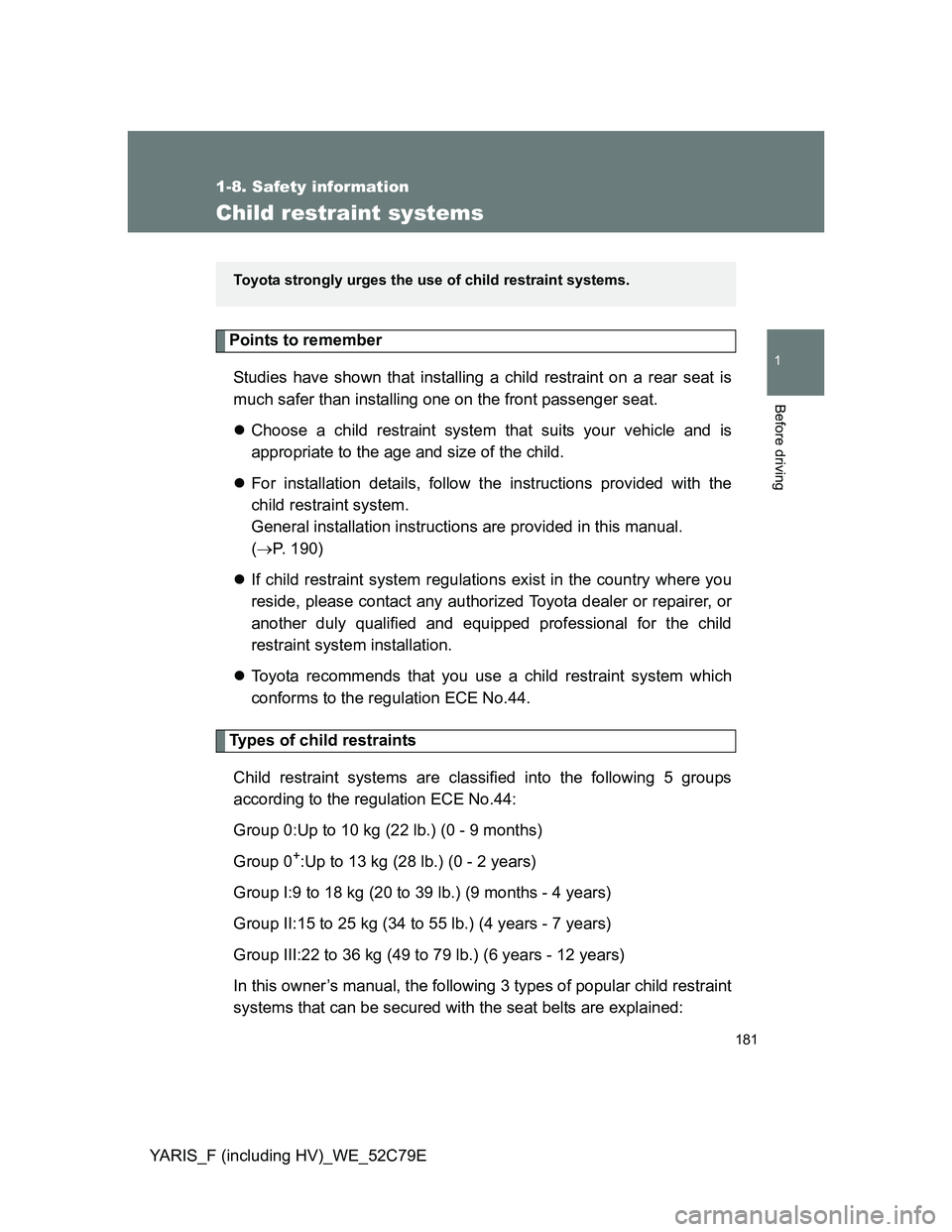
181
1
1-8. Safety information
Before driving
YARIS_F (including HV)_WE_52C79E
Child restraint systems
Points to remember
Studies have shown that installing a child restraint on a rear seat is
much safer than installing one on the front passenger seat.
Choose a child restraint system that suits your vehicle and is
appropriate to the age and size of the child.
For installation details, follow the instructions provided with the
child restraint system.
General installation instructions are provided in this manual.
(P. 190)
If child restraint system regulations exist in the country where you
reside, please contact any authorized Toyota dealer or repairer, or
another duly qualified and equipped professional for the child
restraint system installation.
Toyota recommends that you use a child restraint system which
conforms to the regulation ECE No.44.
Types of child restraints
Child restraint systems are classified into the following 5 groups
according to the regulation ECE No.44:
Group 0:Up to 10 kg (22 lb.) (0 - 9 months)
Group 0
+:Up to 13 kg (28 lb.) (0 - 2 years)
Group I:9 to 18 kg (20 to 39 lb.) (9 months - 4 years)
Group II:15 to 25 kg (34 to 55 lb.) (4 years - 7 years)
Group III:22 to 36 kg (49 to 79 lb.) (6 years - 12 years)
In this owner’s manual, the following 3 types of popular child restraint
systems that can be secured with the seat belts are explained:
Toyota strongly urges the use of child restraint systems.
Page 182 of 704
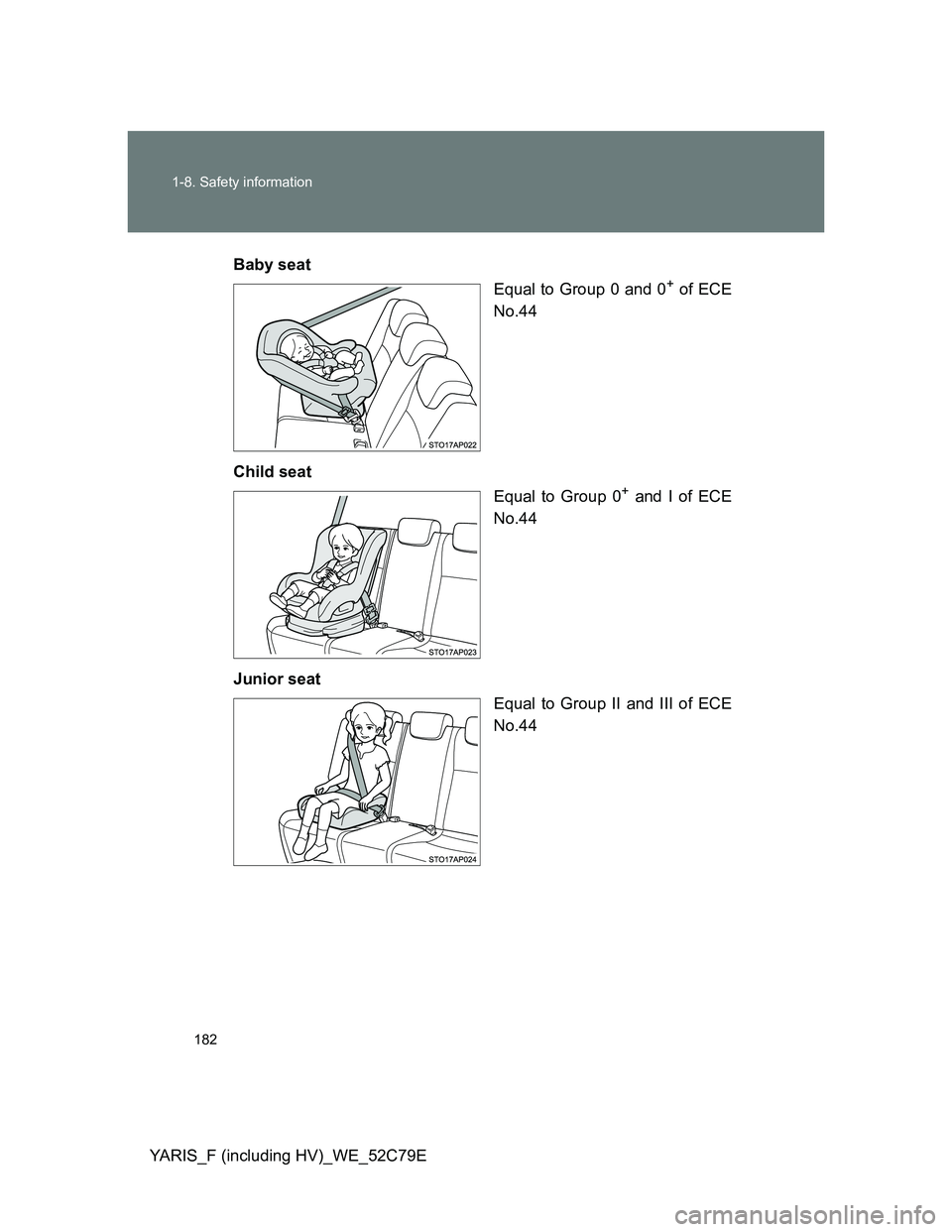
182 1-8. Safety information
YARIS_F (including HV)_WE_52C79EBaby seat
Equal to Group 0 and 0
+ of ECE
No.44
Child seat
Equal to Group 0
+ and I of ECE
No.44
Junior seat
Equal to Group II and III of ECE
No.44
Page 183 of 704
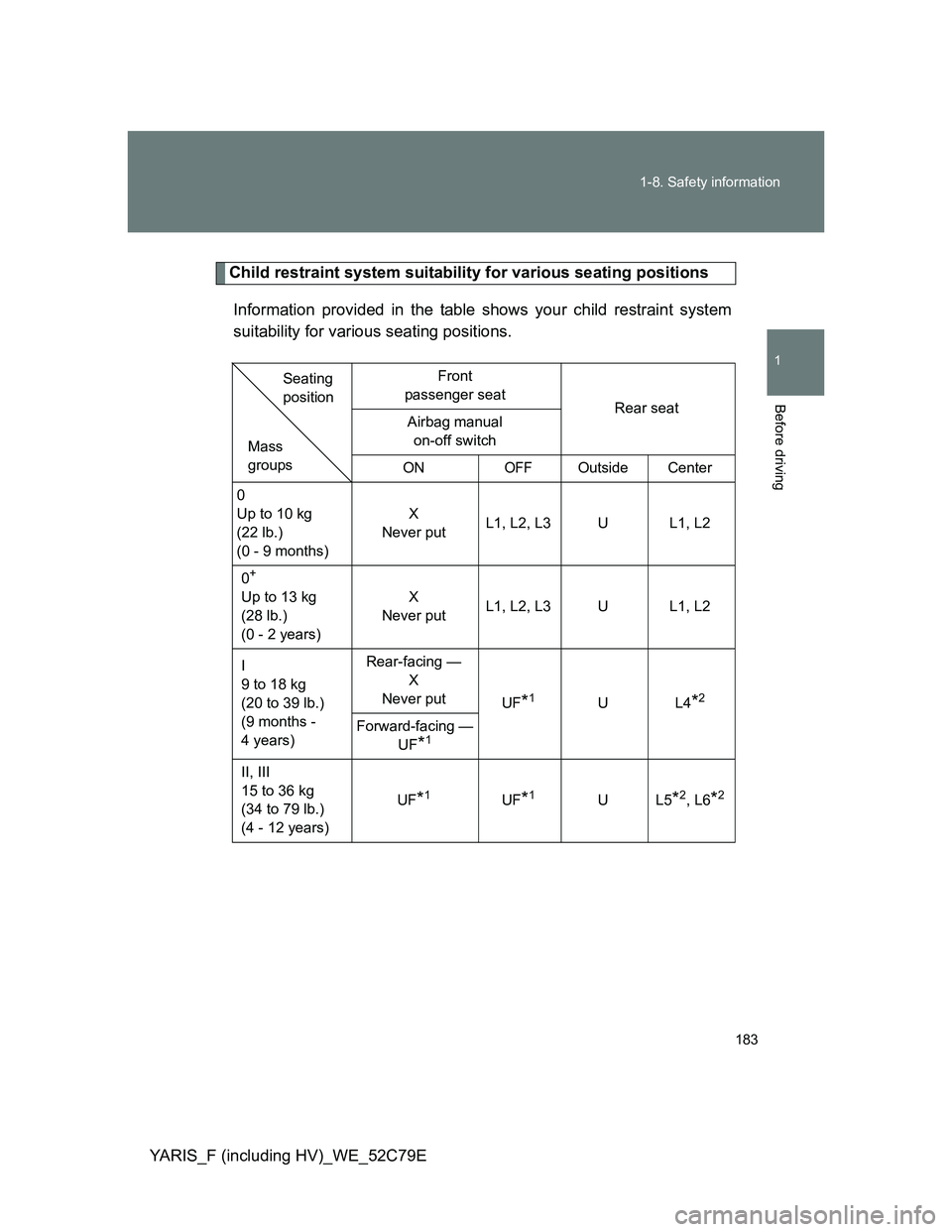
183 1-8. Safety information
1
Before driving
YARIS_F (including HV)_WE_52C79E
Child restraint system suitability for various seating positions
Information provided in the table shows your child restraint system
suitability for various seating positions.
Front
passenger seat
Rear seat
Airbag manual
on-off switch
ON
OFFOutside Center
0
Up to 10 kg
(22 lb.)
(0 - 9 months)X
Never putL1, L2, L3 U L1, L2
0
+
Up to 13 kg
(28 lb.)
(0 - 2 years)X
Never putL1, L2, L3 U L1, L2
I
9 to 18 kg
(20 to 39 lb.)
(9 months -
4 years)Rear-facing —
X
Never put
UF
*1UL4*2
Forward-facing —
UF
*1
II, III
15 to 36 kg
(34 to 79 lb.)
(4 - 12 years)UF
*1UF*1UL5*2, L6*2
Mass
groupsSeating
position
Page 184 of 704
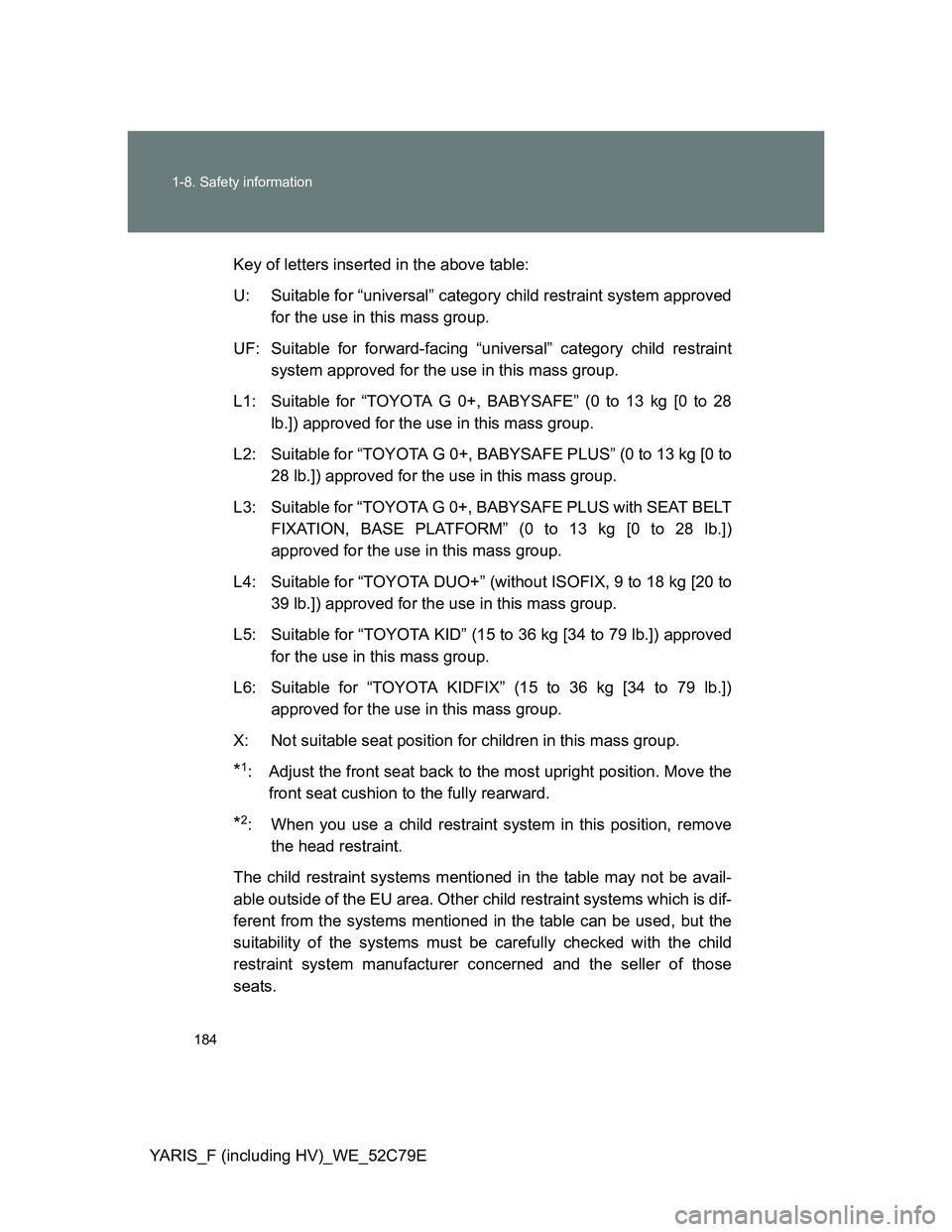
184 1-8. Safety information
YARIS_F (including HV)_WE_52C79EKey of letters inserted in the above table:
U: Suitable for “universal” category child restraint system approved
for the use in this mass group.
UF: Suitable for forward-facing “universal” category child restraint
system approved for the use in this mass group.
L1: Suitable for “TOYOTA G 0+, BABYSAFE” (0 to 13 kg [0 to 28
lb.]) approved for the use in this mass group.
L2: Suitable for “TOYOTA G 0+, BABYSAFE PLUS” (0 to 13 kg [0 to
28 lb.]) approved for the use in this mass group.
L3: Suitable for “TOYOTA G 0+, BABYSAFE PLUS with SEAT BELT
FIXATION, BASE PLATFORM” (0 to 13 kg [0 to 28 lb.])
approved for the use in this mass group.
L4: Suitable for “TOYOTA DUO+” (without ISOFIX, 9 to 18 kg [20 to
39 lb.]) approved for the use in this mass group.
L5: Suitable for “TOYOTA KID” (15 to 36 kg [34 to 79 lb.]) approved
for the use in this mass group.
L6: Suitable for “TOYOTA KIDFIX” (15 to 36 kg [34 to 79 lb.])
approved for the use in this mass group.
X: Not suitable seat position for children in this mass group.
*1: Adjust the front seat back to the most upright position. Move the
front seat cushion to the fully rearward.
*2: When you use a child restraint system in this position, remove
the head restraint.
The child restraint systems mentioned in the table may not be avail-
able outside of the EU area. Other child restraint systems which is dif-
ferent from the systems mentioned in the table can be used, but the
suitability of the systems must be carefully checked with the child
restraint system manufacturer concerned and the seller of those
seats.
Page 185 of 704
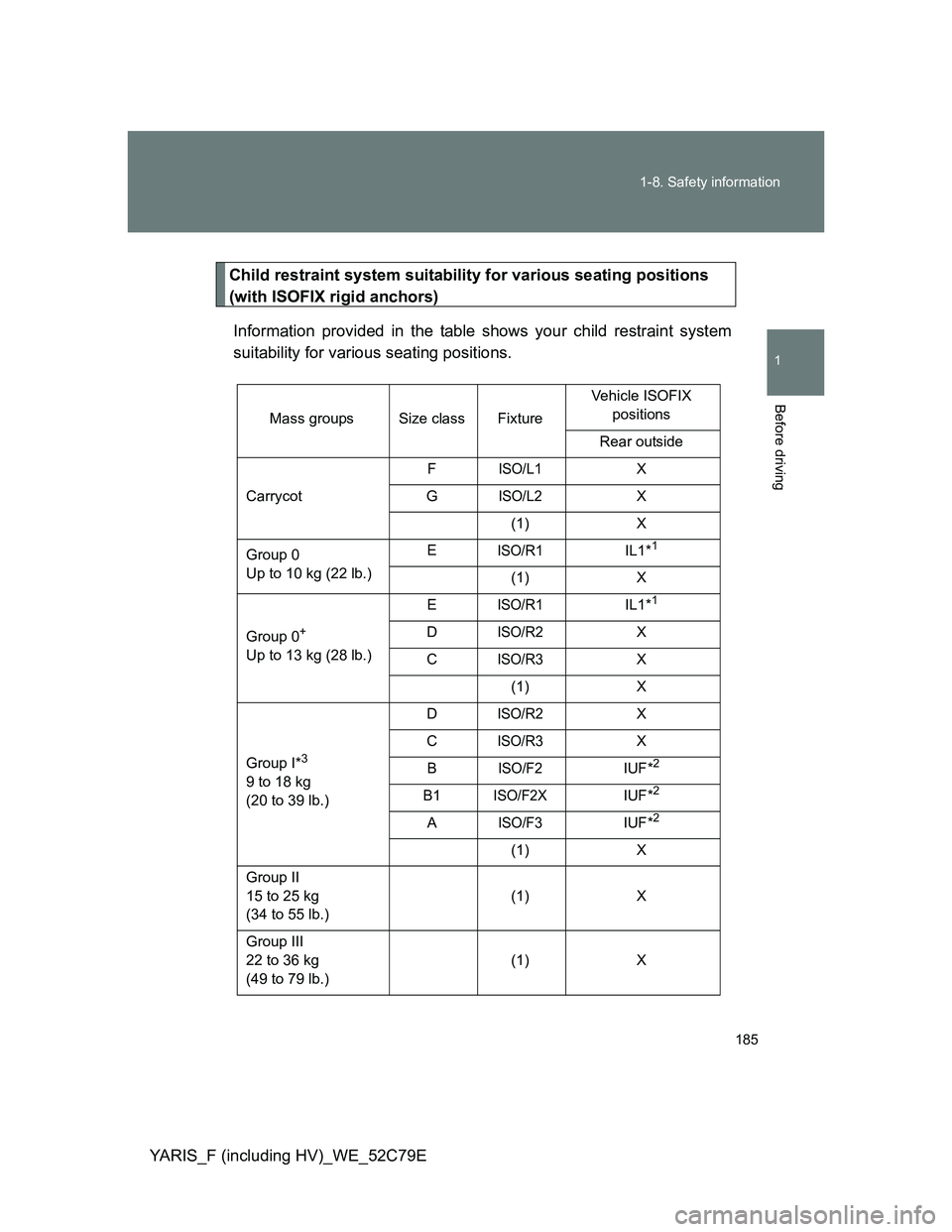
185 1-8. Safety information
1
Before driving
YARIS_F (including HV)_WE_52C79E
Child restraint system suitability for various seating positions
(with ISOFIX rigid anchors)
Information provided in the table shows your child restraint system
suitability for various seating positions.
Mass groups Size class FixtureVehicle ISOFIX
positions
Rear outside
CarrycotF
ISO/L1X
G
ISO/L2X
(1) X
Group 0
Up to 10 kg (22 lb.)E
ISO/R1IL1*1
(1) X
Group 0
+
Up to 13 kg (28 lb.)E
ISO/R1IL1*1
DISO/R2X
C
ISO/R3X
(1) X
Group I*
3
9 to 18 kg
(20 to 39 lb.)D
ISO/R2X
C
ISO/R3X
B
ISO/F2IUF*2
B1ISO/F2XIUF*2
AISO/F3IUF*2
(1) X
Group II
15 to 25 kg
(34 to 55 lb.)(1) X
Group III
22 to 36 kg
(49 to 79 lb.)(1) X
Page 186 of 704

186 1-8. Safety information
YARIS_F (including HV)_WE_52C79E(1) For the CRS which do not carry the ISO/XX size class identifica-
tion (A to G), for the applicable mass group, the car manufac-
turer shall indicate the vehicle specific ISOFIX child restraint
system(s) recommended for each position.
Key of letters inserted in the above table:
IUF: Suitable for ISOFIX forward-facing child restraints systems of
universal category approved for the use in this mass group.
IL1: Suitable for “TOYOTA G 0+, BABYSAFE PLUS with ISO-FIX
FIXATION, BASE PLATFORM” (0 to 13 kg [0 to 28 lb.])
approved for the use in this mass group.
X: ISOFIX position not suitable for ISOFIX child restraint systems
in this mass group and/or this size class.
*1: If the child seat is installed behind a front seat equipped with
height adjuster and the front seat is adjusted below middle
height position, then adjust the front seat head restraint to the
highest position.
*2: When you use a child restraint system in this position, remove
the head restraint.
*3: Toyota recommend to use “TOYOTA DUO+” (with ISOFIX and
TOP TETHER, 9 to 18 kg [20 to 39 lb.]) approved for the use in
this mass group. When using this child seat, adjust it to the most
reclined position.
The child restraint systems mentioned in the table may not be avail-
able outside of the EU area. Other child restraint systems different
from the systems mentioned in the table can be used, but the suitabil-
ity of the systems must be carefully checked with the child restraint
system manufacturer and retailer.
Page 187 of 704
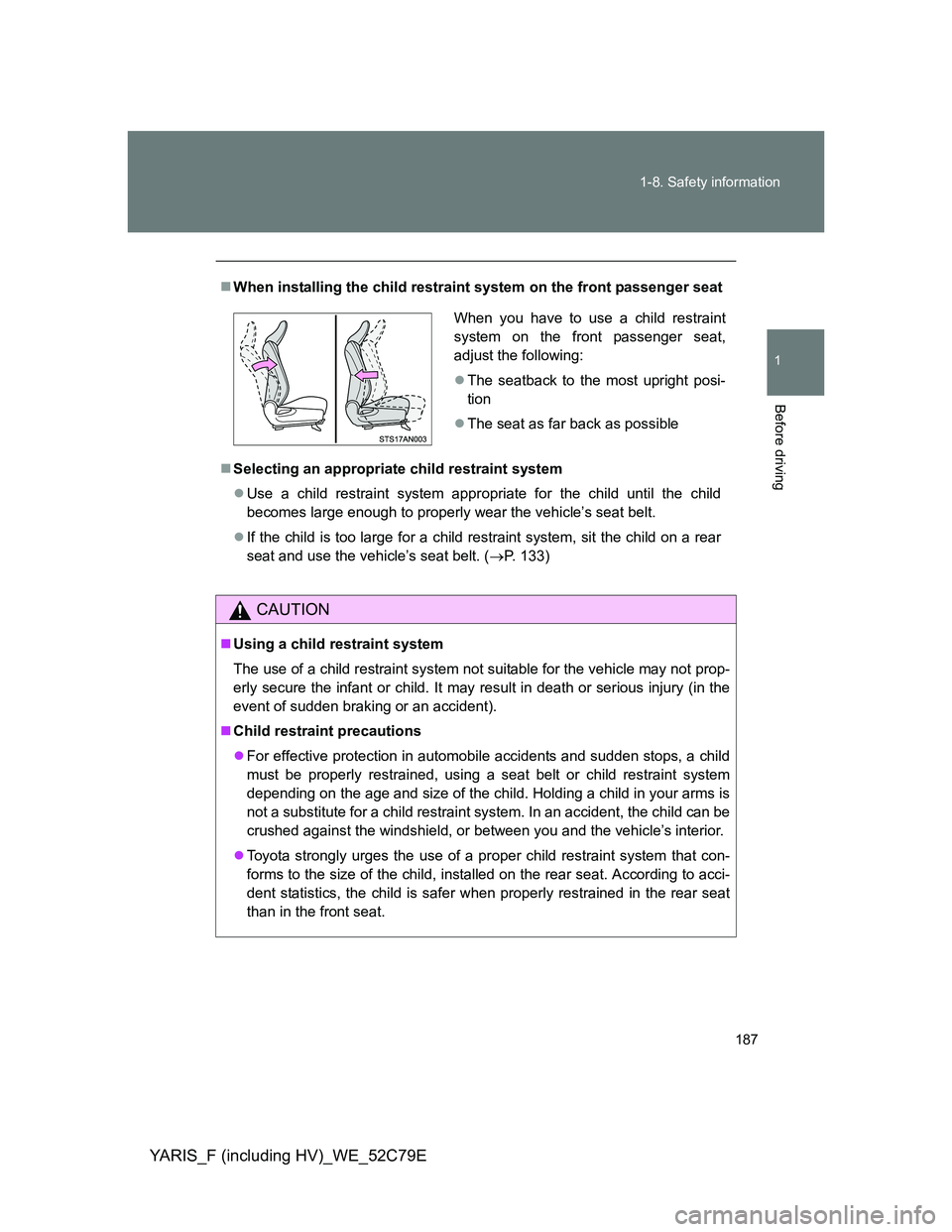
187 1-8. Safety information
1
Before driving
YARIS_F (including HV)_WE_52C79E
When installing the child restraint system on the front passenger seat
Selecting an appropriate child restraint system
Use a child restraint system appropriate for the child until the child
becomes large enough to properly wear the vehicle’s seat belt.
If the child is too large for a child restraint system, sit the child on a rear
seat and use the vehicle’s seat belt. (P. 133)
CAUTION
Using a child restraint system
The use of a child restraint system not suitable for the vehicle may not prop-
erly secure the infant or child. It may result in death or serious injury (in the
event of sudden braking or an accident).
Child restraint precautions
For effective protection in automobile accidents and sudden stops, a child
must be properly restrained, using a seat belt or child restraint system
depending on the age and size of the child. Holding a child in your arms is
not a substitute for a child restraint system. In an accident, the child can be
crushed against the windshield, or between you and the vehicle’s interior.
Toyota strongly urges the use of a proper child restraint system that con-
forms to the size of the child, installed on the rear seat. According to acci-
dent statistics, the child is safer when properly restrained in the rear seat
than in the front seat.
When you have to use a child restraint
system on the front passenger seat,
adjust the following:
The seatback to the most upright posi-
tion
The seat as far back as possible
Page 188 of 704
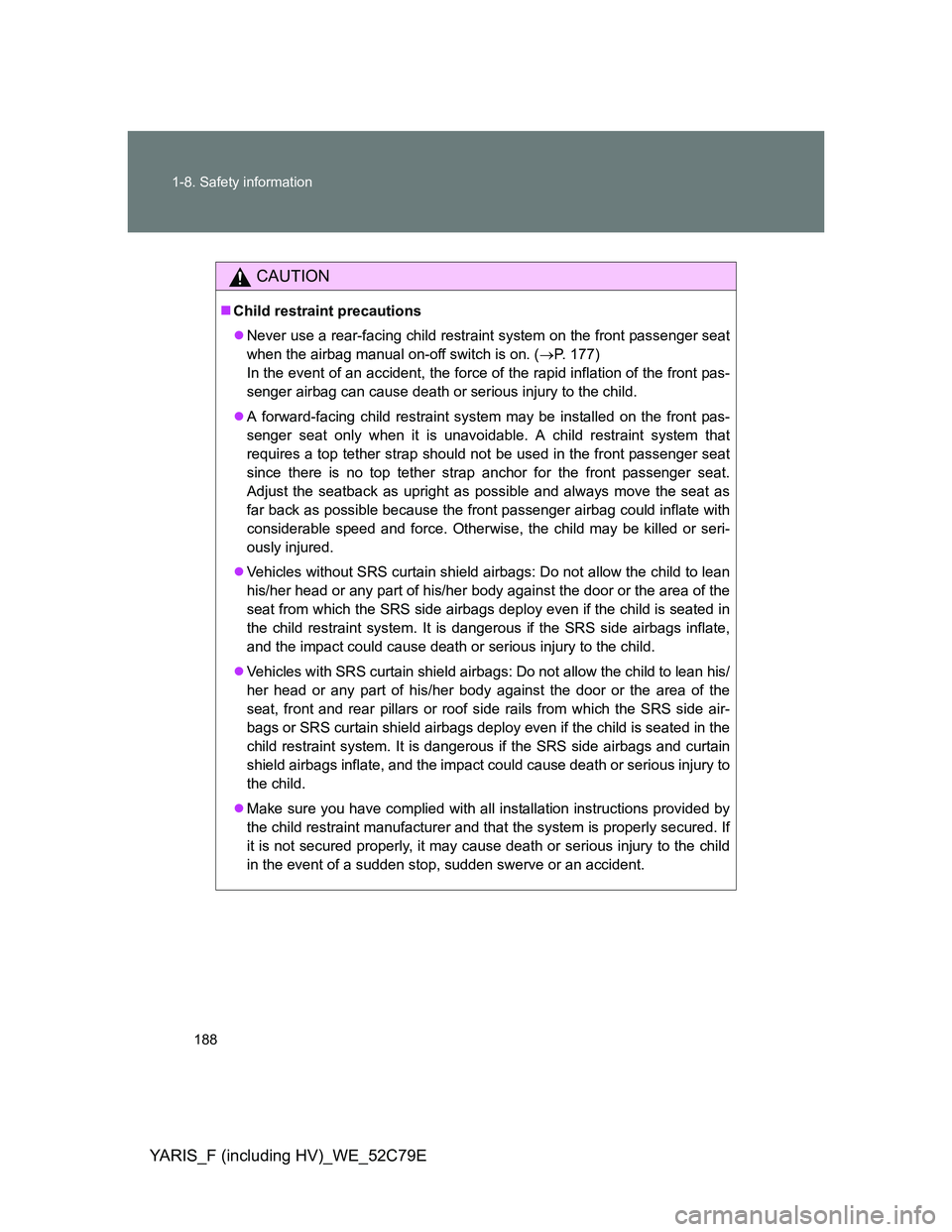
188 1-8. Safety information
YARIS_F (including HV)_WE_52C79E
CAUTION
Child restraint precautions
Never use a rear-facing child restraint system on the front passenger seat
when the airbag manual on-off switch is on. (P. 177)
In the event of an accident, the force of the rapid inflation of the front pas-
senger airbag can cause death or serious injury to the child.
A forward-facing child restraint system may be installed on the front pas-
senger seat only when it is unavoidable. A child restraint system that
requires a top tether strap should not be used in the front passenger seat
since there is no top tether strap anchor for the front passenger seat.
Adjust the seatback as upright as possible and always move the seat as
far back as possible because the front passenger airbag could inflate with
considerable speed and force. Otherwise, the child may be killed or seri-
ously injured.
Vehicles without SRS curtain shield airbags: Do not allow the child to lean
his/her head or any part of his/her body against the door or the area of the
seat from which the SRS side airbags deploy even if the child is seated in
the child restraint system. It is dangerous if the SRS side airbags inflate,
and the impact could cause death or serious injury to the child.
Vehicles with SRS curtain shield airbags: Do not allow the child to lean his/
her head or any part of his/her body against the door or the area of the
seat, front and rear pillars or roof side rails from which the SRS side air-
bags or SRS curtain shield airbags deploy even if the child is seated in the
child restraint system. It is dangerous if the SRS side airbags and curtain
shield airbags inflate, and the impact could cause death or serious injury to
the child.
Make sure you have complied with all installation instructions provided by
the child restraint manufacturer and that the system is properly secured. If
it is not secured properly, it may cause death or serious injury to the child
in the event of a sudden stop, sudden swerve or an accident.
Page 189 of 704
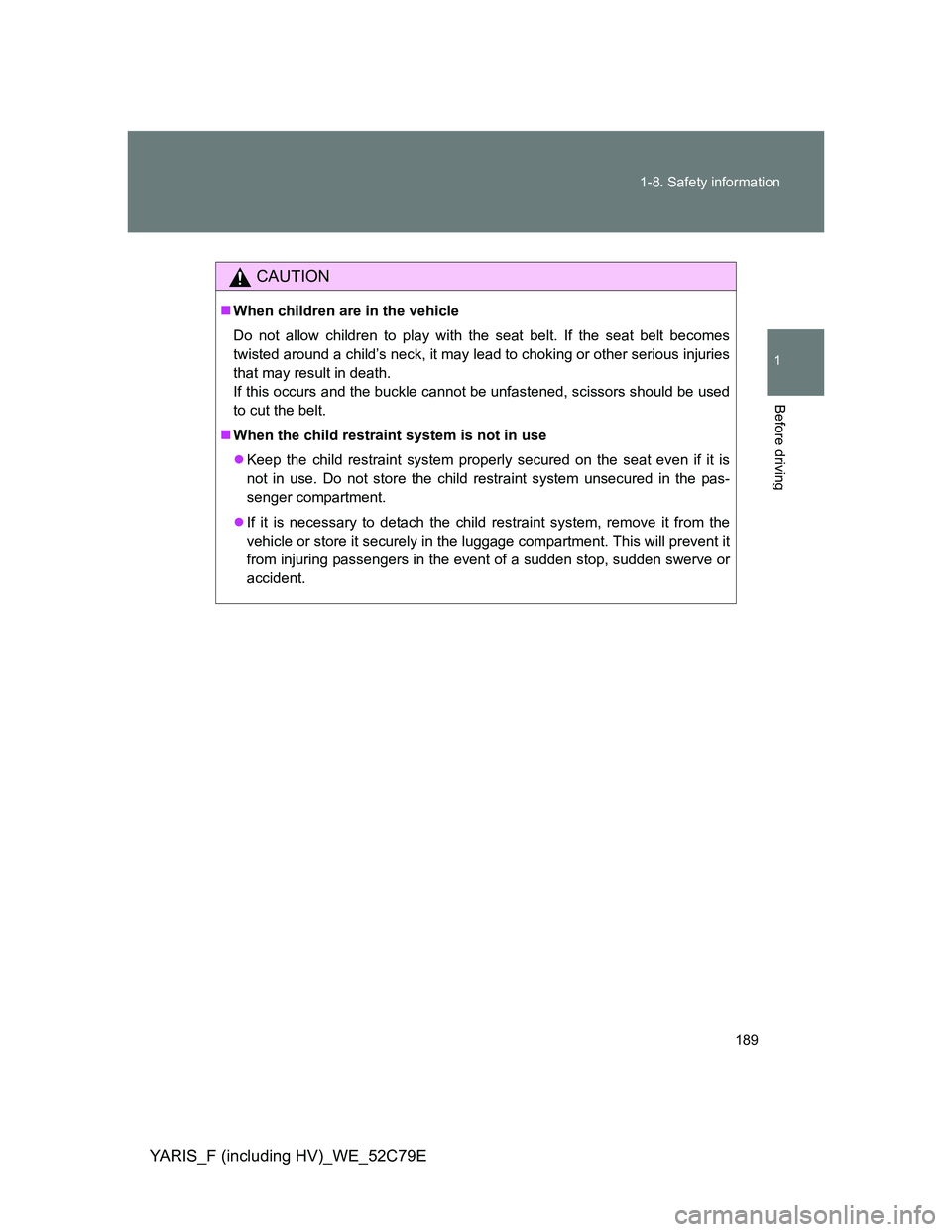
189 1-8. Safety information
1
Before driving
YARIS_F (including HV)_WE_52C79E
CAUTION
When children are in the vehicle
Do not allow children to play with the seat belt. If the seat belt becomes
twisted around a child’s neck, it may lead to choking or other serious injuries
that may result in death.
If this occurs and the buckle cannot be unfastened, scissors should be used
to cut the belt.
When the child restraint system is not in use
Keep the child restraint system properly secured on the seat even if it is
not in use. Do not store the child restraint system unsecured in the pas-
senger compartment.
If it is necessary to detach the child restraint system, remove it from the
vehicle or store it securely in the luggage compartment. This will prevent it
from injuring passengers in the event of a sudden stop, sudden swerve or
accident.
Page 190 of 704
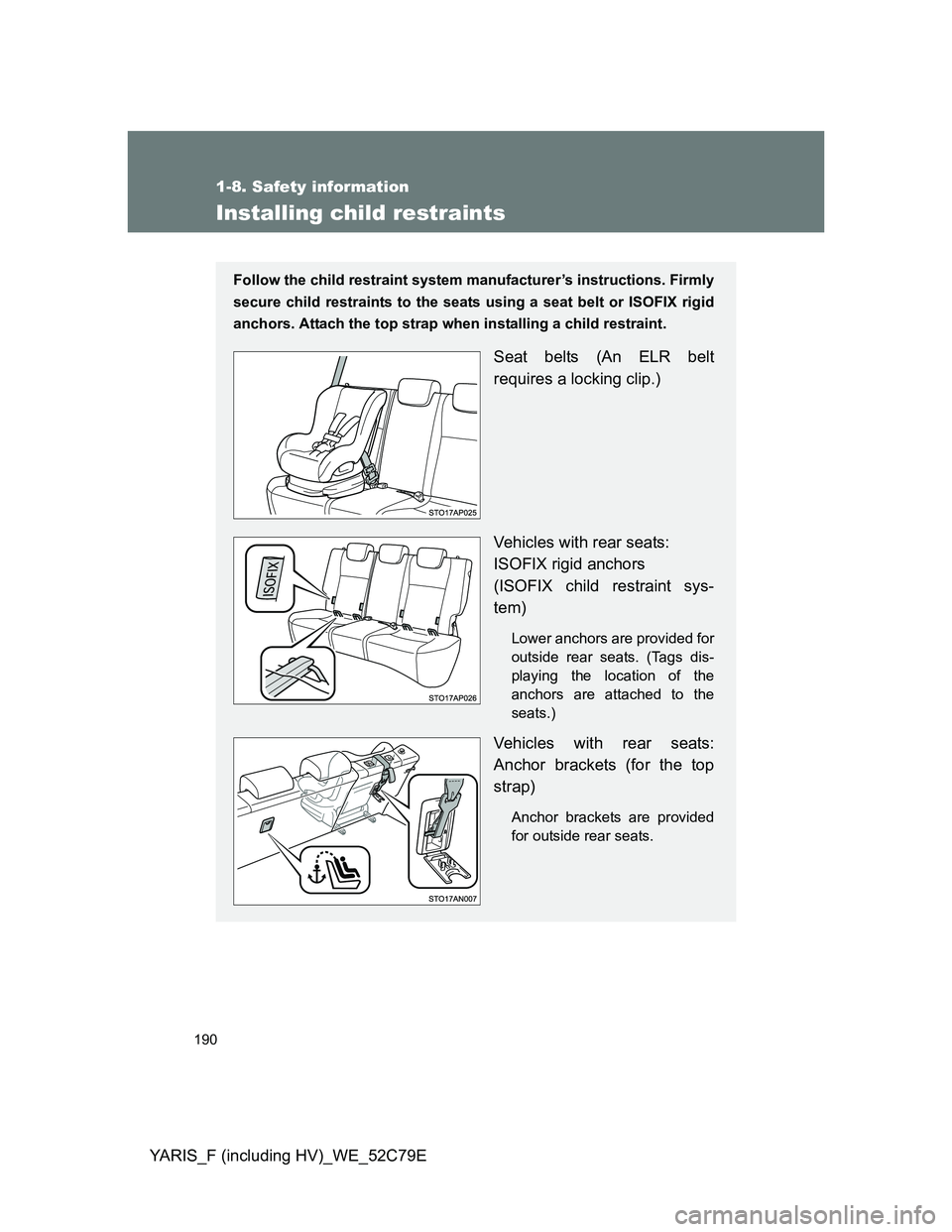
190
1-8. Safety information
YARIS_F (including HV)_WE_52C79E
Installing child restraints
Follow the child restraint system manufacturer’s instructions. Firmly
secure child restraints to the seats using a seat belt or ISOFIX rigid
anchors. Attach the top strap when installing a child restraint.
Seat belts (An ELR belt
requires a locking clip.)
Vehicles with rear seats:
ISOFIX rigid anchors
(ISOFIX child restraint sys-
tem)
Lower anchors are provided for
outside rear seats. (Tags dis-
playing the location of the
anchors are attached to the
seats.)
Vehicles with rear seats:
Anchor brackets (for the top
strap)
Anchor brackets are provided
for outside rear seats.